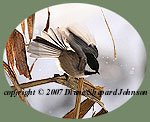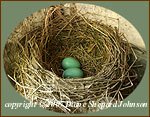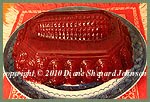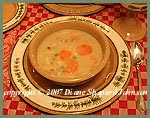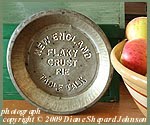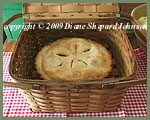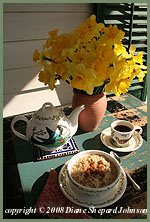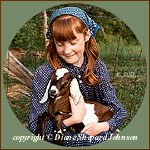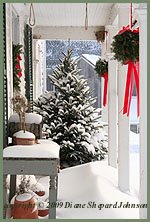Scottish Heritage and Spinning!
The spinning wheel was made in Scotland. Draped on the chair is a Colquhoun tartan shawl.
Click Here for Lovely Music
My 10th great grandfather was William Cahoon (Colquhoun) from Scotland, said to have come to New England as a Prisoner of War after the Battle of Dunbar in 1650.
The Colquhoun family was historically from Loch Lomond, Scotland.
Flicked wool in the grease, ready for spinning.
Tasha Tudor wrote to us:
"That fine red envelope full of photographs and the pages of Family names, was no end impressive."
"Have fun with your genealogical researches. What fun!!"

Draped on the chair is a shawl of the Colquhoun tartan.
We have also included some of the references to sheep, wool, and flax
and the fiber related processing tools including spinning wheels and
looms, etc., in the wills and inventories of my direct line ancestors
with ties to Scotland.
In these old documents the spelling of words is often different than
today. For instance, wheel is sometimes spelled wheale, or woolen is
sometimes spelled wooling. We have retained the original spelling of
items.
My 9th great grandfather Nathaniel Cahoon was the son of William Cahoon (Colquhoun) of Scotland.
My great wheel in the garret. The great wheel is also called the walking wheel or the wool wheel.
Heather from Loch Katrine, Scotland
From an antique Herbarium with many pressed flowers and plants gathered during a European Tour.
The flowers have all been sewn in place.
The old shepherd who had the flock of sheep in the above photograph
lived to be 98 and for years kept sheep on the hillside a ways down the
road from my ancestral family cemetery. The old shepherd was related to
me through an old family line. The trees in the hillside beyond the
pasture show lovely shades of violet, pink, and green.
The spinning wheel and lazy kate were made in Scotland.
A specimen from Abbotsford, the home of Sir Walter Scott.

Cheviot Sheep
A lazy kate made in Scotland, used to hold bobbins whilst plying.
My handspun wool yarn.
My 7th great grandfather Nathaniel Greene mentioned several pieces of spinning and weaving equipment in his will. Nathaniel Greene, son of Rebecca (Cahoon) Greene, was named after his grandfather Nathaniel Cahoon, who was the son of William Cahoon (Colquhoun) of Scotland.

Scottish Highland Cows
The greens and blues of the Colquhoun tartan mimic the colors of the landscape!
A newspaper contest for school children requested "a short answer to the question", "Why is Nature's Prevailing Color Green ?" They chose two entries which shared first place.
My grandmother's answer, written when she was a schoolgirl:
My Grandmum was the 5th great granddaughter of Nathaniel Greene, the 6th great granddaughter of Rebecca (Cahoon) Greene, the 7th great granddaughter of Nathaniel Cahoon, and the 8th great granddaughter of William Cahoon (Colquhoun) of Scotland.
My Grandmum as a girl.
Wren on a mossy log.
A Wren family had a nest house in the apple tree next to the mossy log.
"The wee birdies sing..."

A thistle with the Colquhoun tartan.
A hatchel for combing flax.
Another of my Scottish ancestors:
One of the things listed in the inventory was a cosset sheep. A cosset was a motherless or rejected lamb hand fed by people; a pet sheep.
In a genealogy published in Boston in 1874, Ebenezer Weaver Peirce b. 1822, who was likely related to several of our ancestral families, wrote this story of his cosset sheep:
"The writer of this genealogy, when a small boy, was made happy as the recipient of a present from his father; that acceptable gift being a cosset sheep, that like "Mary's lamb" followed, if allowed, wherever I went, in doors and out, and even up and down stairs. That sheep I loved almost as I loved my own life, and was made to feel exceedingly wretched by an injury that it received, being hooked by an ox so as to tear the skin in a manner shocking to behold. Mrs. Howland happened to call at my father's, and witnessing my grief and sorrow desired to see the sheep; and on examining the injuries, pronounced them curable, and then sewed up the wound and dressed it so nicely that it healed ere long. I never thought of that woman afterwards but with feelings of gratitude for the wound she also healed in my lacerated young heart."
A shawl that I am knitting with my handspun yarn, naturally dyed with goldenrod.
It is done in seed stitch as I prefer it to garter stitch. I find it more pleasing to the eye and more interesting to knit.
In the garden is Iris Florentina.
Orris root is a ground powder from the rhizomatous roots of Iris Florentina. The orris root smells delightful! I think it has a smell like sweet violets. I love it!

A pat of Corgyncombe Butter stamped with a thistle print.
Butter churned at Corgyncombe Dairy using the cream from Corgyncombe Dairy goat Carmella Lucille's milk. My butter churn is a reproduction of a churn Tasha Tudor had. My husband planted cosmos in the vegetable garden at my request, for cut flowers to be arranged in bouquets.
Tasha Tudor illustrated two versions (1947 and 1981) of "A Child's Garden of Verses" written by Robert Louis Stevenson who was Scottish. In the 1981 version are several little boys wearing Scottish kilts and a little girl wearing a tartan frock with a Scottish cap.
Tasha Tudor had a Scottish Nanny when she was a little girl. Tasha wrote on the dedication page of her illustrated version of "Mother Goose": "To Mary Denny Burnett", who was her Scottish Nanny. The words are surrounded by Tasha's illustration of thistles.
Also in "Mother Goose" Tasha Tudor illustrated a Scottish bagpiper playing to a cow.
Beatrix Potter went to Scotland on holidays.


Scottish Highland Cows
Cahoon waters
Some of the photographs and some of the writings on this post are from previous Corgyncombe Courant posts that can be found here on the Corgyncombe Courant and from our web site and our previous postings elsewhere on the internet.
Please do not "Pin" our photographs.
Please do not post our photographs on facebook.
Our email:
atthecottagegate@yahoo.com
If you receive an email you think is from me from this email, please make sure it is atthecottagegate@yahoo.com, and not just something that sounds similar.
Photographs, images, and text copyright © 2000-2023 Diane Shepard Johnson and Sarah E. Johnson.
All rights reserved. Photographs, images, and/or text may not be reproduced in any form without permission in writing from Diane Shepard Johnson and Sarah E. Johnson.
http://corgyncombecourant.blogspot.com/2023/07/dreams-of-scotland.html
copyright © 2023 Diane Shepard Johnson and Sarah E. Johnson
~~~~~~~~~~~~~~~~~~

